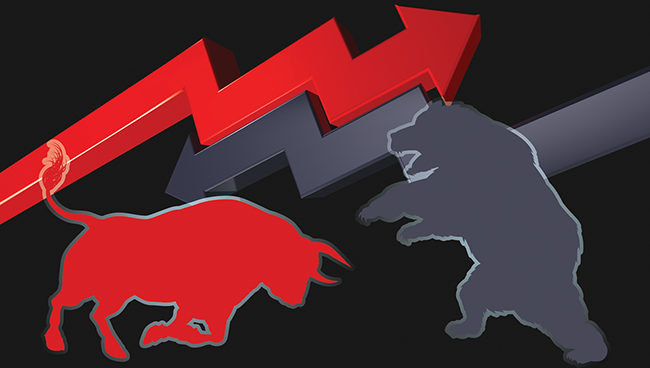Trending
Crash course
How an opaque economic outlook is changing NYC real estate — and how it isn’t

U.S. stocks took a beating toward the end of 2018. After reaching an all-time high of more than 26,800 in early October, the Dow Jones Industrial Average fell more than 5,000 points by Christmas.
Add to that market miasma a perpetually deadlocked federal government, interest-rate hikes and an escalating trade war, and the economic outlook for 2019 looks cloudier than ever while predictions about a coming recession percolate.
Although the Dow recovered somewhat in January, New York’s real estate industry finds itself navigating some rough waters amid the ongoing backdrop of economic uncertainty. Here’s a look at how some key industry players are responding.
Residential opportunities
As stock market returns become less of a sure thing, some say investors are again turning to tangible investments such as real estate — a potential windfall for the city’s lethargic residential market.
“My clients have pulled substantial amounts of money out of the [stock market] and do not want to sit on cash,” said Keller Williams broker Seth Levin. “I’ve had many conversations with them about taking advantage of the low competition and favorable buyers’ market we are experiencing here in New York.”
Of course, in times of indecision, pulling the trigger on a major investment can be hard for buyers as well, perhaps dampening the extent of a potential bounce back.
Warburg Realty agent Mihal Gartenberg said her American clients are often warier during bear markets and need to be persuaded of the benefits of buying property when stocks are volatile. But she noted that her “international clients consider real estate a stronger investment during times of economic uncertainty.”
The shift in buyer sentiment is most noticeable in the luxury residential market, where the slowdown has been the most pronounced, brokers say. The median asking price for Manhattan condos hit a low of $2.1 million in August, but since then it has started to rise, reaching $2.25 million in December, according to StreetEasy data.
And despite recent Federal Reserve hikes, interest rates remain at historically low levels, which should also encourage buyers.
“I think this market could be the perfect storm for a buyer, with rates still relatively low coupled with the fact that sellers are now more inclined to price their homes appropriately with where the market is today,” said Ace Watanasuparp, vice president of residential lending at Citizens Bank.
In fact, long-term fixed mortgage rates have dropped by nearly half a percentage point from their October peak. Nonetheless, future rate increases could change things quickly and spur more on-the-fence buyers into action.
“You’re not going to see a great sense of urgency until we go up by 1 percent,” Watanasuparp said. “But as rates start to inch up, you’ll see more people feel like they have to make a move if they want to purchase a home and leverage financing.”
Cloudy commercial forecasts
In contrast to the residential slowdown, New York City office leasing has held strong for the past two years. Annual leasing volume hit an all-time high in Midtown last year with more than 20 million square feet, according to CBRE, while the citywide total of 32 million was the highest since 2014.
Investment sales in the city also broke a two-year slump with nearly $50 billion in sales, according to Cushman & Wakefield. But stock market volatility could slow down that activity, sources say.
“For better or worse, there’s been a very strong relationship between the S&P 500 and New York office rents, historically,” said Heidi Learner, chief economist at the commercial real estate firm Savills Studley. “The financial sector by and large still drives office leases, even though as a percentage of overall employment its impact has been reduced.”
A loss of market confidence and a spreading fear of a recession would be clear negatives for commercial real estate in the city. Another factor that could affect the industry is foreign exchange rates, with many analysts predicting a further weakening of the U.S. dollar in 2019.
“Certainly, dollar weakness is not good for existing investments, but it’s often good for drawing foreign investors to take another look at the U.S. market,” Learner said.
At the same time, it remains unclear if a weak U.S. dollar will attract more foreign investors this time around, with signs of volatility in overseas markets and prices for New York commercial real estate already at cycle-high levels.
A record-long U.S. government shutdown and the Fed’s next moves could also put a damper on activity. But as the central bank holds more frequent press conferences — after each of its eight yearly policy meetings rather than once per quarter — that increased transparency could alleviate ambiguity about future rate increases.
“I think there is some concern that maybe the Fed has not been as mindful of what the market seems to be signaling,” Learner said.
Venture capitalists stay the course
With so much of the city’s real estate industry in private hands, many companies have managed to dodge the recent public market turbulence.
One big exception is homebuilders, who incurred large losses in 2018. The XHB, a popular exchange-traded fund that tracks homebuilding businesses, lost 27 percent in value last year. New York-based real estate investment trusts SL Green and Vornado also lost 20 percent of their value last year, though they bounced back in January.
“Apart from the homebuilders who got hit really hard, and some public REITs who got hit less hard in certain sectors, we haven’t seen much impact one way or the other when we go and talk to our real estate partners,” said Zach Aarons, co-founder of the real estate advisory firm and technology accelerator MetaProp NYC.
For the most part, private equity investors and venture capitalists try their best to ignore public market conditions. The amount of venture capital waiting to be deployed has reached record levels, and funds have little incentive to slow down.
Venture capitalists invested $138 billion into U.S. startups in 2018, the largest sum since the dot-com crash in 2000, according to Barron’s.
“A good VC will tell you they’re going to invest in a downturn, they’re going to invest in an upturn, they’re going to back the best companies, the best teams and the best products that are going to fundamentally change the way business is done,” Aarons said. “It shouldn’t necessarily matter whether that’s in a good market or bad market.”
Aarons noted that both short-term rental giant Airbnb and ride-hailing platform Uber received their first venture funding in 2009, during the depths of the last recession. On the other hand, he said, Facebook was first funded in 2004 in a healthy economy — another indication that venture funding doesn’t always correlate to public market conditions.
Though funds could perhaps use lower public valuations as leverage in their negotiations with startups, the opacity of private capital markets can make this strategy less effective.
“The risk is that an entrepreneur just takes that term sheet down [Silicon Valley’s] Sand Hill Road and finds someone who will do it at a better valuation,” Aarons said. “So that’s sort of a dangerous game to play.”




